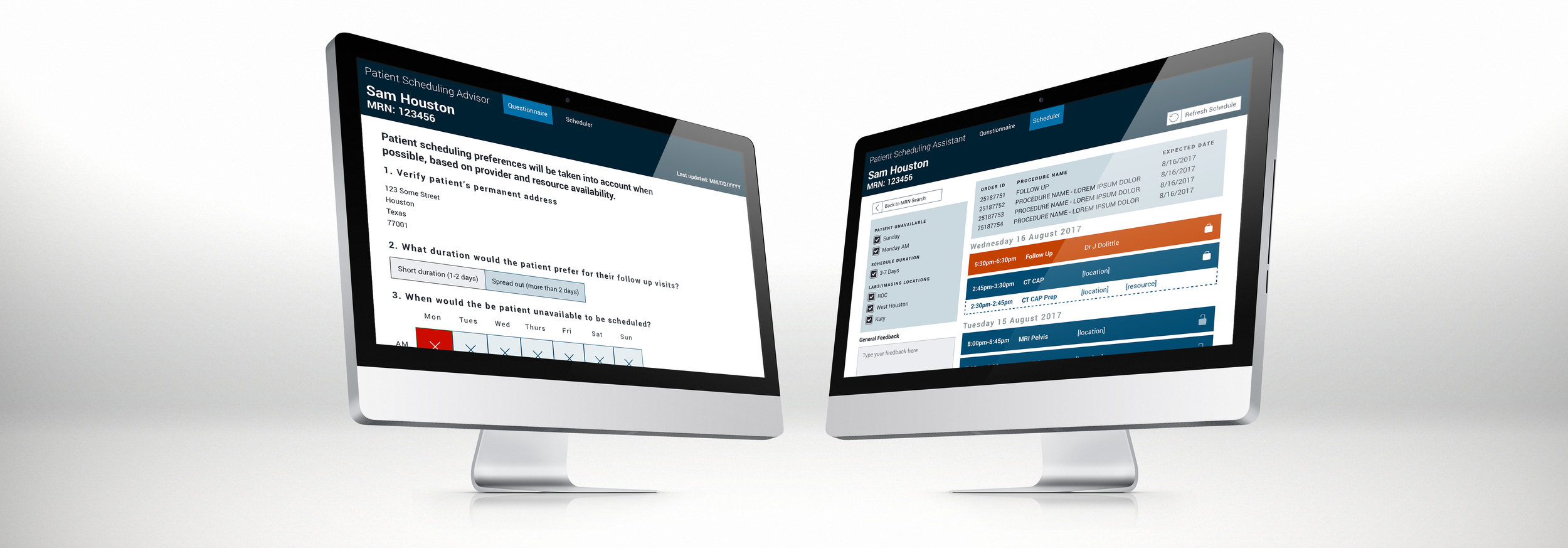Patient Scheduling Advisor
I led the user-centered design for a proof-of-concept AI scheduling tool that helped cancer ward schedulers create optimal patient schedules while incorporating patient preferences. Working with a large Houston hospital, I designed a complementary application that integrated with Epic medical software to balance over 100 scheduling rules with individual patient needs.
My Role & Approach
Key contributions
Led user-centered design for initial use case discovery workshop with hospital staff
Facilitated proto-persona creation with patient scheduling team and medical staff
Conducted user research through interviews and testing with patient schedulers
Designed patient preference collection workflow integrated with check-in process
Iterated scheduling interface based on changing requirements, API constraints, and user feedback
The Challenge
Design an application for scheduling staff of a large cancer ward to create optimal patient schedules that:
Pulled appointment data from Epic medical software
Accounted for patient preferences
Managed over 100 scheduling rules
Fit within existing scheduler workflows
My Approach
I led the user-centered design elements of this proof of concept, which included:
Workshop facilitation: Leading use case discovery with hospital staff
Cross-functional collaboration: Working alongside the project manager, machine learning experts, and front-end developers
User research: Meeting with patient schedulers to conduct testing and validate design assumptions
Iterative design: Refining designs based on user feedback and changing technical constraints
Understanding Schedulers and Patients
Initial Two-Day Workshop
I facilitated a two-day workshop with the patient scheduling team and associated medical staff to ground the project in user needs.
Proto-Persona Creation: I led the team through creating proto-personas based on identified patient types. This exercise ensured everyone approached the project from a user-centered perspective rather than starting with technical capabilities.
Goal Evolution: Through the workshop, the project goal evolved from a loosely defined "optimizing of schedules" to a more focused solution: a complementary application that sat alongside Epic medical software. This application would:
Incorporate patient preferences
Account for the 100+ scheduling rules patient schedulers must consider
Integrate with existing workflows rather than replacing them
Key Personas Identified: Based on the workshop, we identified distinct patient types with different scheduling needs:
Local patients with flexible availability
Out-of-state patients preferring concentrated appointment schedules
Working patients with limited weekday availability
Patients with mobility challenges requiring specific location considerations
Elderly patients with varying levels of technology comfort
Workshop whiteboard capturing proto-persona creation and initial use case exploration with hospital staff
Preference-Informed Scheduling
Collecting Patient Preferences
To incorporate and learn from patient preferences, we first needed to design a mechanism to collect them.
Options Explored:
Online portal: Leveraging the hospital's existing patient portal
Mail questionnaires: Sending preference forms by mail
Research Insights: Through interviews with schedulers, I uncovered critical concerns:
Computer literacy barriers: Many elderly patients struggled with online systems
Low response rates: Mail questionnaires historically had poor completion rates
Timing issues: Both methods introduced delays before scheduling could begin
Solution: Check-In Integration Based on scheduler insights, I identified an opportunity within the existing check-in process. As patients arrived on the ward, front desk staff could collect preferences as part of standard intake.
Questionnaire Design
I designed a brief questionnaire that front desk staff would complete with patients, capturing:
Permanent address verification - Identifying travel distance considerations
Schedule duration preference - Short (1-2 days) vs. spread out (3-7 days)
Availability - Days/times the patient is unavailable (AM/PM grid by day of week)
Location preferences - Preferred zones for lab work and imaging procedures
This approach:
Required no additional technology adoption from patients
Fit naturally into existing workflows
Achieved high completion rates
Provided preferences immediately when needed
Scheduler Interface Design
Initial Approach: Multiple Schedule Options I initially explored providing multiple schedule options, allowing schedulers to pick the best fit for each patient. However, user testing revealed critical issues:
API overhead: Multiple schedule generation required excessive calls to Epic
Analysis paralysis: Schedulers struggled to compare and choose between options
Time prohibitive: The comparison process slowed rather than accelerated scheduling
Refined Solution: Single Optimized Schedule Based on this feedback, I pivoted to providing a single recommended schedule. This approach:
Reduced technical overhead through fewer API calls
Eliminated decision paralysis for schedulers
Maintained scheduler control through refresh capability
Handling Real-Time Conflicts: As schedulers worked through appointments, availability in Epic could change. I designed a workflow where schedulers:
Progress through the suggested schedule
When encountering conflicts with Epic availability, lock completed appointments
Refresh remaining appointments to regenerate based on current constraints
This approach:
Reduced cognitive load by focusing on one schedule at a time
Minimized API calls through selective refresh
Preserved scheduler progress through appointment locking
Reverse Chronological Display
Through scheduler interviews, I learned that all appointments were dependent on the primary care provider appointment, which determined the patient's treatment timeline.
Design Decision: I designed the schedule to display in reverse chronological order, starting with the primary care provider appointment and working backward through prep, travel, imaging, and lab appointments.
Supporting Features:
Travel time calculations: Automatically accounted for movement between hospital locations
Prep time indicators: Showed required preparation time before procedures
Location context: Clearly displayed which zone/building each appointment would occur in
This display order matched schedulers' mental model of how they thought about the scheduling problem, reducing cognitive translation time.
Impact & Outcomes
Proof of Concept Success
Validated Approach:
Demonstrated feasibility of preference-informed scheduling
Showed integration potential with Epic medical software
Proved value of machine learning in healthcare scheduling optimization
Scheduler Feedback:
Appreciated the single-schedule approach over multiple options
Valued the reverse chronological display matching their workflow
Found the lock-and-refresh mechanism intuitive for handling real-time changes
Strategic Value
For Healthcare Schedulers:
Reduced manual effort in balancing 100+ scheduling rules
Incorporated patient preferences that were previously difficult to track
Maintained scheduler expertise and control while providing AI assistance
For Patients:
Voice in the scheduling process through preference collection
More convenient appointment timing
Reduced travel burden through location optimization



